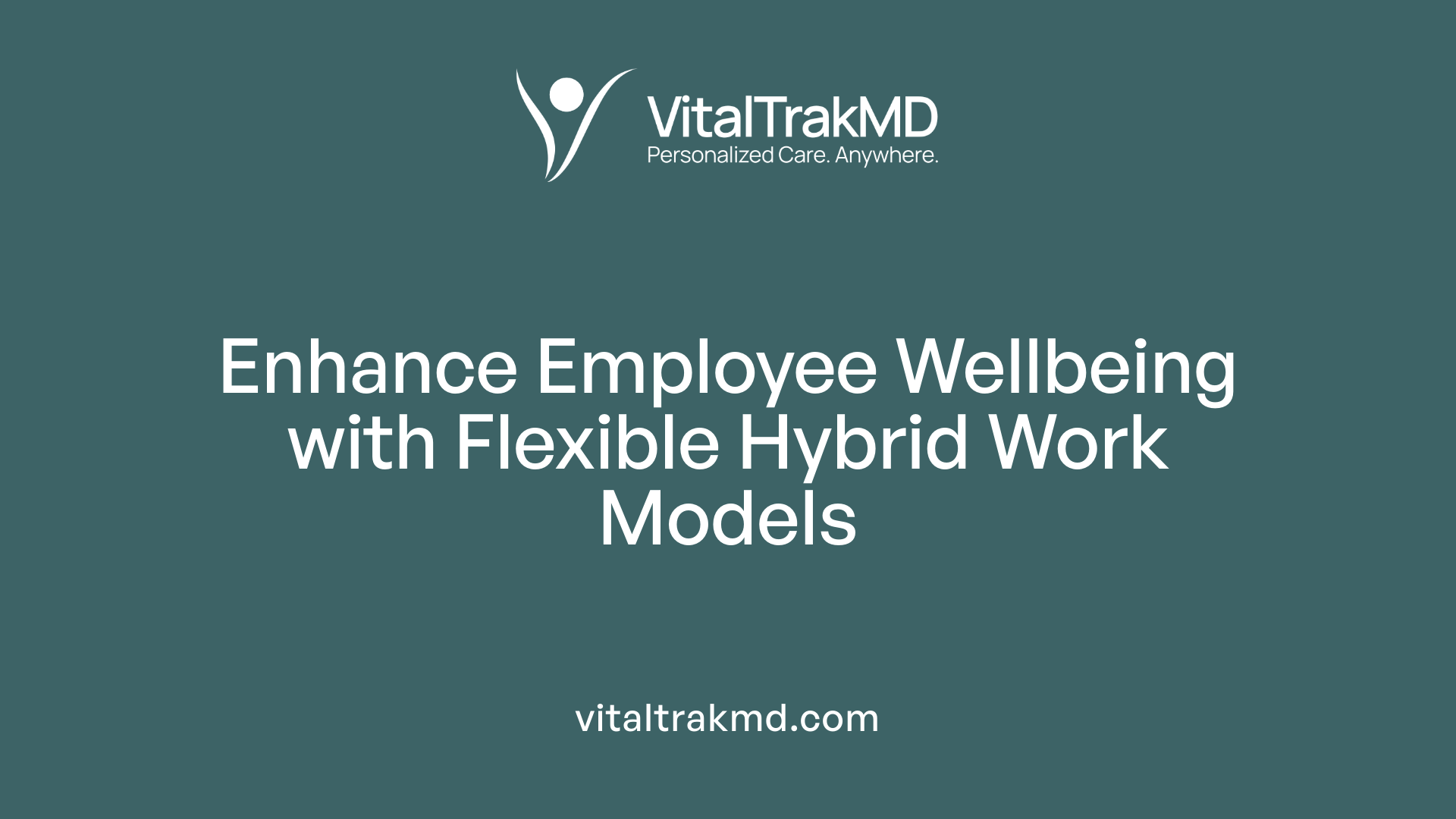Why Hybrid Programs Enhance Motivation to Maintain Healthy Habits

Introduction to Hybrid Wellness Programs and Motivation
In today's dynamic work environments, hybrid wellness programs have emerged as a pivotal strategy in promoting and maintaining healthy habits among employees. These programs, which combine in-person and digital approaches, leverage technological advancements and organizational support to foster motivation and sustain health behaviors over the long term. Understanding how these hybrid approaches effectively motivate individuals can inform better implementation and engagement, ultimately leading to improved health outcomes and organizational benefits.
The Influence of Hybrid Work Models on Employee Wellbeing

How do hybrid work models contribute to employee health and wellbeing?
Hybrid work models have become increasingly popular due to their ability to boost overall employee health and wellbeing. By offering a flexible schedule that blends in-office and remote work, employees experience a better balance between their professional and personal lives.
This flexibility reduces workplace stress and helps prevent burnout, a common issue in traditional office settings. Surveys indicate that hybrid workers tend to have improved sleep patterns, more motivation, and healthier lifestyle habits, including increased exercise and better eating choices.
Additionally, working remotely decreases exposure to environmental pollutants and reduces the risk of contagious illnesses, benefitting physical health. On the downside, certain ergonomic issues, such as improper home office setups, can pose challenges, making ergonomic management essential.
Social connections may weaken in hybrid arrangements, which can affect mental health and team cohesion. However, with intentional social activities and wellness programs, organizations can foster a sense of community.
Research shows that hybrid work arrangements contribute to higher job satisfaction, more frequent promotions, and lower resignation rates, notably benefiting women and those with long commutes.
Implementing supportive policies, ergonomic assessments, and wellness initiatives ensures that the benefits of hybrid work are maximized, supporting both physical and psychological health among employees.
The Power of Digital Tools in Wellness Programs

What are the benefits of integrating digital tools like fitness apps into wellness programs?
Using digital tools such as fitness apps and comprehensive health assessments has transformed how organizations promote employee wellness. These platforms facilitate easy access to health resources, making it simple for employees to engage regardless of their location or work schedule.
Fitness apps enable users to set personal goals, track their daily activities, and receive real-time feedback. This continuous monitoring helps individuals stay motivated and committed to healthier habits, whether they are working remotely or in a hybrid environment.
One major advantage is the ability to collect valuable data on health behaviors and outcomes. Employers can analyze this information to assess overall program effectiveness and identify areas needing improvement. This data-driven approach allows for precise adjustments tailored to the needs of different groups or individuals.
Moreover, digital health tools often incorporate features like gamification—such as challenges or leaderboards—to foster engagement. Social features encourage peer support and accountability, which boost participation rates.
In summary, adopting digital wellness tools enhances program accessibility, personalization, and measurable results. This integration not only supports healthier behaviors among employees but also helps organizations lower healthcare costs and improve overall well-being.
Synergizing Multiple Health Strategies through Hybrid Programs

How do hybrid programs that combine multiple health strategies enhance motivation?
Hybrid wellness programs that blend various health approaches effectively boost employee motivation by meeting diverse personal preferences and needs. Incorporating physical activities, such as virtual fitness challenges and movement breaks, with mental health resources like stress management workshops and mindfulness sessions, creates a comprehensive support system. These initiatives foster a sense of community and belonging, especially when combined with social engagement activities like team challenges or wellness events.
Flexibility plays a crucial role. On-demand wellness options, personalized feedback based on health assessments, and accessible virtual resources allow employees to participate at their own pace and comfort level. This personalization makes health initiatives more relevant and less burdensome, encouraging ongoing involvement.
Leadership support and visible organizational commitment are vital. When companies recognize and celebrate wellness achievements, employees feel valued and motivated to maintain healthy behaviors. The combined effect of personalized, flexible, and community-oriented programs forms a supportive environment conducive to sustained motivation.
Overall, hybrid programs that integrate physical, mental, and social health support create a holistic wellness culture. This approach not only promotes healthier lifestyles but also reduces burnout, enhances job satisfaction, and sustains engagement across different work settings.
How can organizations effectively combine in-person and virtual wellness initiatives to foster motivation?
To successfully merge in-person and virtual wellness efforts, organizations should offer flexible, easily accessible activities tailored to a diverse workforce. Virtual options like live-streamed fitness classes, on-demand workout videos, and online mental health resources allow employees to participate regardless of location or schedule.
Building community is essential. Including social components such as team-based challenges, virtual trivia contests, or informal coffee chats encourages interaction and camaraderie. These activities foster a sense of belonging, which is crucial for motivation in hybrid environments.
Leadership involvement and public recognition of wellness milestones reinforce organizational commitment. Regular communication about available resources and success stories boosts awareness and participation.
A holistic approach is key. Integrating mental health support, physical fitness options, and social activities through easily navigable platforms ensures employees feel supported both professionally and personally. Cultivating a culture that values well-being, inclusivity, and empathy sustains motivation.
By combining these strategies—flexible offerings, social engagement, leadership visibility, and accessible resources—organizations can effectively motivate employees to engage in health-promoting behaviors, ultimately creating a healthier, more productive hybrid workforce.
The Evidence and Challenges in Sustaining Healthy Behaviors in Hybrid Settings

What evidence exists regarding the impact of hybrid wellness programs on health behavior maintenance?
Research on hybrid wellness programs indicates a combination of promising potential and current limitations. For example, a recent study involving university faculty and staff explored the effects of a hybrid program-based on motivational models and gamification—on adolescents' physical fitness and activity levels. While this program led to significant improvements in physical fitness measures, its short duration and specific focus mean that direct evidence of sustained health behavior changes in adult employees remains limited.
Quantitative data from similar initiatives often show minimal immediate differences in health markers, such as cholesterol or blood pressure, after short-term interventions typically spanning around six weeks. This suggests that lasting health behavior change tends to require longer or more intensive engagement. Conversely, qualitative feedback from participants commonly highlights increased motivation, job satisfaction, and perceptions of work-life balance, which are vital for long-term adherence.
Broader research on the impact of hybrid work models underscores various benefits. Employees report reduced stress, better sleep, and increased physical activity, all of which contribute indirectly to maintaining healthier habits over time. Though direct, measurable outcomes remain elusive in some cases, these psychological and emotional improvements are crucial for fostering ongoing healthful behaviors.
In summary, current evidence suggests that while hybrid wellness programs may not always produce immediate measurable health improvements, they positively influence attitudes, motivation, and overall well-being. These factors serve as foundational elements that can lead to sustained health behaviors if supported by ongoing engagement and tailored interventions.
| Evidence Source | Impact on Health Behavior | Duration | Additional Notes |
|---|---|---|---|
| University of British Columbia study | Improved physical fitness, increased activity | 1 academic year | Significant fitness improvements, less sedentary time |
| Short-term workplace studies | Limited immediate health marker changes | 6 weeks | Highlight need for longer-term approaches |
| Broader hybrid work research | Reduced stress, better sleep, higher activity | Ongoing | Psychological benefits support behavior maintenance |
Understanding these dynamics helps organizations craft more effective, sustainable wellness strategies in hybrid environments.
The Long-term Benefits of Hybrid Wellness Strategies

Why do hybrid programs enhance motivation to maintain healthy habits?
Hybrid wellness programs motivate individuals to adopt and sustain healthy habits by combining the best of in-person and digital approaches. These programs offer personalized support through health coaching, biometric assessments, and engaging challenges that adapt to individual needs. Virtual fitness challenges, mental health resources, and community activities help create a supportive environment, reducing feelings of isolation and increasing motivation.
Leadership involvement and flexible program design foster a culture that values health and well-being. Incentives, whether low or high budget, further encourage participants to stay committed. Components like access to health screenings, rewards, and ongoing assessments help maintain focus on health goals over time.
By addressing medical, psychological, and social aspects of well-being, hybrid programs foster a positive and motivating environment. This comprehensive approach supports long-term adherence to healthy behaviors, benefiting both individuals and organizations.
What strategies are effective for combining in-person and virtual wellness initiatives to foster motivation?
Effective integration of in-person and virtual wellness initiatives relies on flexibility and inclusivity. Offering on-demand workout videos, mental health resources, and personalized plans allows employees to choose activities that fit their schedules. Virtual challenges and team-based goals help build camaraderie and a sense of community among hybrid workers.
Leadership participation and recognition of wellness achievements reinforce organizational commitment and motivate ongoing engagement. Social activities, such as trivia nights, coffee chats, or group challenges, foster connection and motivation.
Access to mental health and physical wellness tools, along with clear communication about available resources, ensures employees feel supported and valued. Creating a holistic wellness culture that emphasizes empathy, inclusivity, and proactive health practices helps sustain motivation.
This blend of strategies not only boosts individual health but also promotes a cohesive, motivated workforce in a hybrid work environment.
Supporting Data and Trends
| Aspect | Details | Additional Notes |
|---|---|---|
| Hybrid Work Preference | 83% of employees prefer hybrid models for better work-life balance | Indicates a strong employee preference for flexible work arrangements |
| Employer Strategies | Only 26% have clear hybrid wellness strategies | Highlights the need for more structured programs |
| Physical Activity Decline | 60% of employees reduce movement by over 50%; nearly half take fewer than 1,000 steps daily | Shows the necessity for targeted activity promoting initiatives |
| Wellness Program Elements | Virtual fitness classes, challenges, ergonomic setups, mental health resources | These are vital components for engaging hybrid employees |
| Inclusion Challenges | Accessibility issues for remote workers; solutions include remote fitness programs | Ensuring all employees can participate is critical |
Future Directions in Hybrid Wellness
Research indicates that well-designed hybrid wellness programs can lead to sustained health improvements, organizational benefits, and enhanced employee satisfaction. Future exploration might focus on refining personalization through AI, expanding mental health support, and developing scalable models for diverse workforces.
Long-term studies examining behavioral adherence and health outcomes will clarify best practices. Additionally, integrating technological innovations like virtual reality fitness or advanced biometric tracking could revolutionize hybrid wellness offerings.
By continuously adapting strategies to evolving workplace dynamics, organizations can sustain health benefits, reduce healthcare costs, and foster thriving, resilient work environments.
Final Thoughts: The Future of Hybrid Wellness and Motivation
As organizations recognize the multifaceted benefits of hybrid programs, the focus on integrating digital tools, ensuring accessibility, and fostering community becomes crucial. While evidence on long-term behavior change continues to evolve, it is clear that hybrid wellness programs significantly contribute to improved motivation, engagement, and overall health. Future research and organizational strategies should prioritize tailored, inclusive, and flexible approaches to maximize these benefits, ultimately supporting healthier, more productive workforces in an increasingly hybrid world.
References
- The Why of Wellness - How Programs Work and Why They' ...
- The Seneb's Enigma: Impact of a Hybrid Personal and ...
- How to Promote Physical Well-being in a Hybrid Workplace
- The 6 Benefits of Including a Fitness App in Your Employee ...
- Maximize the Impact of Your Corporate Fitness Center
- Winning Wellness Programs for Hybrid Teams
- 12 Ways To Prioritize Employee Well-Being In The Hybrid- ...
- 12 Strategies for Hybrid-Remote Employee Well-Being
- How to Design and Implement Health and Wellness ...
Recent articles
Want to Feel Better and Live Healthier?
Join hundreds of patients taking control of their health with personalized care that fits their life – not the other way around.
Rated 4.8/5 by 32+ customers







